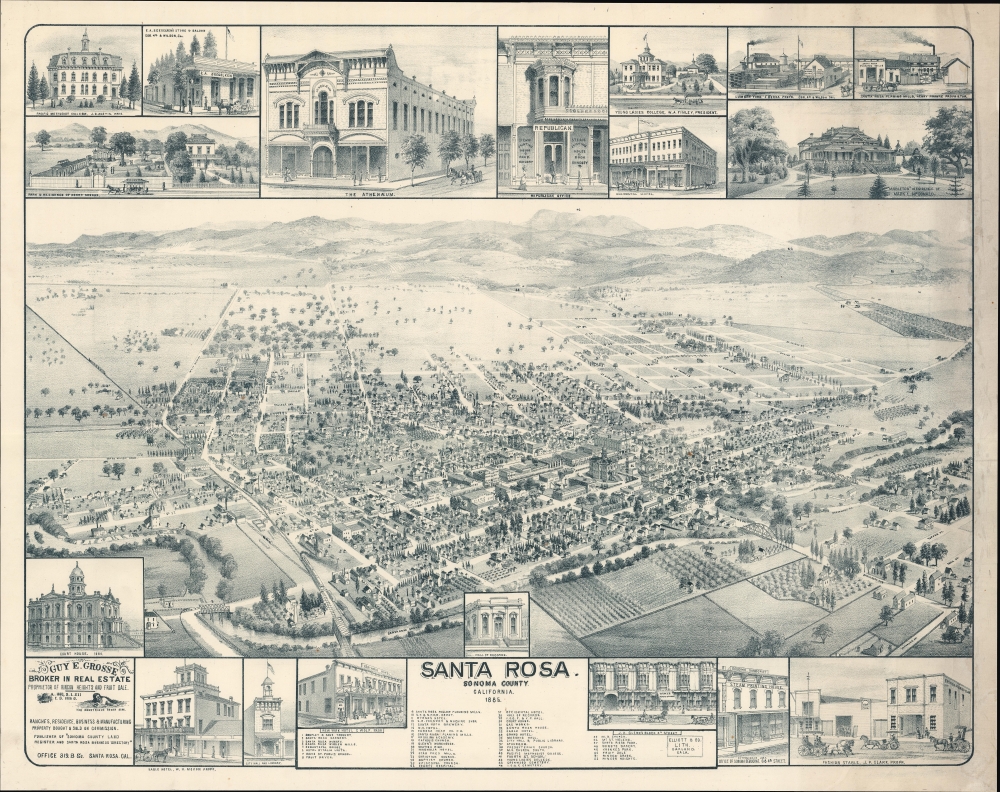1885 Elliott Bird's Eye View of Santa Rosa, California
SantaRosa-elliott-1885
Title
1885 (dated) 20.5 x 26 in (52.07 x 66.04 cm)
Description
A Closer Look
Oriented towards the northeast, with Mt. St. Helena in the background, this view displays Santa Rosa and the surrounding countryside, numbering 52 sites, which are listed in an index at bottom. A number of these sites, including hotels, newspaper offices, residences, educational institutions, and government offices, appear as one of the 18 vignette illustrations surrounding the view. Many of these businesses and institutions are situated along 4th Street. Perhaps the most curious of these is the skating rink (number 20), one of the first in California, where the game of roller polo proved especially popular.Also noteworthy is the large mansion of Mark L. McDonald at top-right. Through his experience in the mining industry, McDonald met and became a business partner of George Hearst, later a U.S. Senator, and went on to a string of successes (he later became a close associate of two of California's 'Big Four,' Leland Stanford and Charles Crocker). In 1879, McDonald moved to Santa Rosa and purchased large tracts of land to build homes and design streets for the city's growing population, leaving a permanent mark on its layout.
Santa Rosa, as seen here, was still a relatively young city, only settled by the family of prominent Californio ranchera María Ygnacia López de Carrillo in the mid-1830s. The grid was laid out in the mid-1850s, and the city was not incorporated until 1868. Afterward, the railroad's arrival (discussed below) led to the steady growth of Santa Rosa in the late 19th century.
The Old Courthouse
One particularly noteworthy structure is the Sonoma County Courthouse, which stands out prominently in the view and is illustrated at bottom-left, above the advertisement for real estate broker Guy E. Grosse. As indicated, the courthouse was completed only the year before the view's publication, replacing a spacious plaza (to the annoyance of some residents, including Berthold Henry 'Barney' Hoen, one of the town's founders who had earlier donated land for the plaza). In any event, the 1884 courthouse, like much of Santa Rosa, was destroyed in the great 1906 earthquake (which more famously devastated San Francisco). It was rebuilt in 1908 but finally torn down in 1966, reverting to a public plaza known as 'Old Courthouse Square.'Santa Rosa Railroads
The rail line at left is the San Francisco and North Pacific Railroad, the first standard-gauge railway in Sonoma County, reaching Santa Rose from Petaluma in 1870. Soon after this view's publication, the S.F. and N.P.R.R. would be incorporated into the Northwestern Pacific Railroad. At the same time, a second rail line, the Santa Rosa and Carquinez Railroad, would link Santa Rosa to Napa Junction to the southeast.American City Views
City views were being produced in the United States as early as the 1830s, but the genre exploded after the American Civil War (1861 - 1865). Bridging the gap between maps and pictures, most 19th-century American bird's-eye views presented cities to the public from high points: some imagined, but others drawn from hot-air balloons or nearby hills. The presentation, combining high elevation, commercial interest, and new printing technology, created a uniquely American art form, as described by historian Donald Karshan,Some print connoisseurs believe that it was only with the advent of the full-blown city-view lithograph that American printmaking reached its first plateau of originality, making a historical contribution to the graphic arts. They cite the differences between the European city-view prints and the expansive American version that reflects a new land and a new attitude toward the land.The vogue for bird's-eye city views lasted from about 1845 to 1920, during which period some 2,400 cities were thus portrayed, some multiple times. Although views were produced in many urban centers, Milwaukee, Wisconsin, was the nexus of view production in the United States. The major American viewmakers were Stoner, Wellge, Bailey, Fowler, Hill Ruger, Koch, Burleigh, Norris, and Morse, among others.
Publication History and Census
This view was drawn by an unknown artist and printed by W.W. Elliott and Co. in Oakland. It is quite rare, noted in the OCLC among the holdings of the University of Michigan and the American Antiquarian Society. The Amon Carter Museum of American Art and the University of California Berkeley also hold examples. An OCLC listing (5406340) is dated 1885 but, in fact, lists examples of a facsimile reproduction printed in a limited run in 1972. Reps notes examples of the original at the Huntington Library and the California Society of Pioneers, but these can not be confirmed in those institutions' catalogs.Cartographer
Wallace William Elliott (fl. c. 1879 - 1891) was a short-lived but important lithographic artist, printer, and publisher based in the San Francisco Bay Area. The firm's (often but not always W.W. Elliott and Co.) output consists almost entirely of bird's-eye views of California cities (listed in Reps), along with histories of the young state's counties. Some other works also dealt with Arizona, Idaho, and the Pacific Northwest. Very little is known about Elliott (aside form being born in New York in 1842 and residing in Alameda County in his most active years) or his firm, which appears to have had operations in both San Francisco and Oakland. More by this mapmaker...

